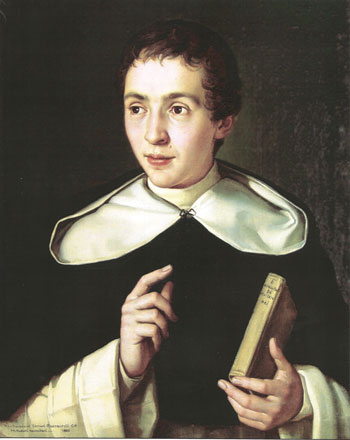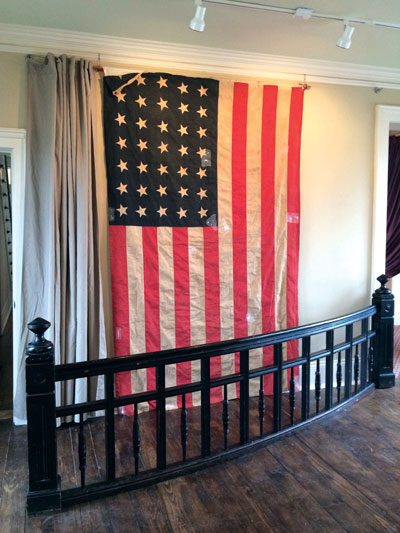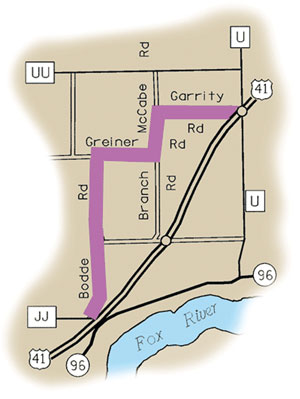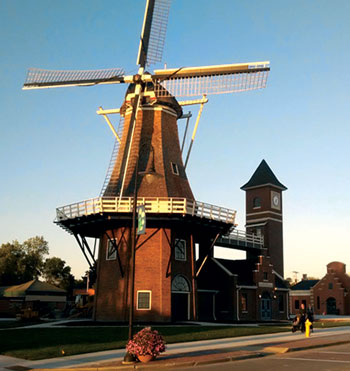Traveling back in time
Every piece of history tells a story. Each community also has its tales to tell and artifacts to be discovered.
FOX CITIES Magazine unearthed four accounts that contribute to the fabric of the area’s past.
Stars and stripes
Today, the United States flag waves a proud 50 stars, and 13 alternating red and white stripes
representing the original colonies, but it didn’t always look that way. The Neenah Historical Society was happy to discover an unknown treasure during a cleaning day toward the end of 2014 at the Hiram Smith Octagon House.
“We were upstairs going through things and putting things away and came across this,” says Emily Runnerstrom, education and program coordinator for the Neenah Historical Society, motioning to a 35-Star Flag in a state of repair. The flag had been found semi-folded inside a plastic bag. It was donated in 1998 by a former Neenah resident and took about six weeks after discovering it again before everyone began to realize the type of artifact they had in their possession. “We’re going through the efforts of preserving it and it’s going to take up the whole wall over here,” Runnerstrom added.
The flag, being repaired by Runnerstrom and her mother JoEllen Wollangk, also a Neenah Historical Society volunteer, has become an unexpected and integral part of the historical society’s new exhibit, “When Neenah Came Marching Home.”
“It really is very serendipitous. If we did not find the flag when we did, it probably would
not have made it into the exhibit,” says Runnerstrom.
The exhibit will celebrate the sesquicentennial of the end of the Civil War and include what it was like for soldiers to come home following the war, along with the issues they faced — unemployment, post-traumatic stress and more. A mini grant was provided by the Wisconsin Humanities Council to produce the exhibit, opening this month.
“There are probably millions and billions of 50-Star Flags that were made,” Wollangk says, but 35-Star Flags were only made for a two-year period from 1863–65 for the admission of West Virginia.
In preserving the flag, Wollangk and Runnerstrom did internet research and talked to other experts for advice. They started by using a vacuum with screens to clean the flag and had to be careful of three main components — oils in hands, sunlight and letting the material rest — when working on the artifact. Normally, gloves would be worn while handling an old artifact, but since the material was being sewn, gloves would likely have inadvertently been sewn to the flag, Wollangk explains. While the flag also was in the sunlight, it was only during periods of mending to avoid possible additional fading of the fabric.
“UV and infrared rays are some of the worst at weakening textiles,” says Runnerstrom, who notes there also is a positive aspect of displaying the flag. “If we can’t use textiles and art to educate the community, then we’re doing a disservice.”
Muslin also was attached to the back of the flag to decrease the stress of hanging it to a metal rod. Insect mounting pins, smaller in size than traditional sewing pins, were used to hold the flag together as stitching was taking place. Crepeline, a super fine silk, was utilized to stop tears from ripping further, but not mend them completely.
“All of these holes and markings are part of its history,” Runnerstrom explains.
The stitches were intentionally made so they “very easily could be clipped,” notes Wollangk who worked for the Outagamie County Historical Society for 20 years. In total, about a month was spent working on the efforts.
While working on the flag, two unique items were discovered. On the back, the initials “T.E.P.” are visible. Wollangk believes they might be an indicator of the possible owner. There’s also a stitched “B” on the flag, which could be linked to a member of Company B and be a sign that it traveled during the Civil War.
Jane Lang, executive director of the Neenah Historical Society, is looking forward to the opening of “When Neenah Came Marching Home” to the public on May 3 and hopes the response is as good if not better than the historical society’s last award-winning exhibit, “Take Cover, Neenah! Backyard Family Fallout Shelter,” which saw 4,000 visitors. The new exhibit is expected to remain open until the fall of 2016. Hours for May and June are 1-5 p.m. on Sundays and by appointment.
Lang describes “When Neenah Came Marching Home” as “a complement to local history and an understanding that history isn’t far off, it’s accessible.” During the Civil War, the population in Neenah and the surrounding area actually increased from approximately 1,500 people at the beginning of the war to about 1,800 residents by the end and grew to 3,000 residents following the war, Lang shares. Eighty-seven soldiers from the area also perished during the war. An exhibit panel will explain the relation of the Civil War to Neenah to put things in perspective, Lang says.
“It will bring history right to Neenah the same way the fallout shelter exhibit did,” she adds.
The exhibit will include approximately 20 informational panels, letters C.B. Clark wrote home to his mother during the war, recorded journal entries, images, uniforms, weapons and the song “Lorena” which was written by Rev. Henry D.L. Webster who moved to Neenah after creating the words of the mournful ballad that became popular with soldiers of both sides during the war. Lang notes that it was challenging to decide what to display.
“How do you limit what we have to the space we have?” she shares.
The exhibit also will include hands-on opportunities and a medicinal garden planted by the Winnebago County Gardeners when the weather warms. Lang would like to challenge visitors to the exhibit to also think about what they have that will stand the test of time after discovering many letters still in good condition from the Civil War era. “Electronic data, will it last? Who knows,” Lang says. She hopes the exhibit will spark conversation and create a thought-provoking dialogue among multiple generations.
Unearthing the past
“It’s always nice when you can verify what we’ve accepted or add to the information we knew,” says Dr. Richard Boyd, an independent researcher working with the Wisconsin and Kaukauna Area historical societies.
Boyd, who grew up in Kaukauna, began his interest in history during his preteen years when he met William F. Wolf who was deeply intrigued by the area’s history. Wolf has since passed, but prior to his death, he shared much of his knowledge with Boyd who has aimed to preserve the stories of the Kaukauna area — one of them being that of an unknown cemetery.
“I’m not trying to rewrite history, but confirm what history has been,” Boyd remarks. “It’s been underfoot for many years.”
The cemetery is near the grounds of Trinity Lutheran Church in Kaukauna and could extend further, he adds.

Father Samual Mazzuchelli.
Photo courtesy of Mazzuchelli Collection. Sinsinawa Dominican Archives, Sinsinawa, Wisconsin.
In 1830, Father Samuel Mazzuchelli was assigned by Cincinnati Bishop Edward Fenwick to do missionary work in the Northwest Territory. He could speak French and Italian, but not much English and no Native American, Boyd says. Mazzuchelli went on to set up an unnamed church in the area the same year. In 1835, he left to start a parish in Green Bay, Boyd shares.
“Some of the very first (Native Americans) converted to Catholicism after that faith wasn’t around for almost 100 years” are suspected to have been buried in the cemetery, Boyd notes of the second oldest Christian burial site in the state.
During the World War II era, strange impressions were discovered in the area that was later believed to be where the cemetery lies. It was thought that coffins with their lids flipped open were creating the effect. Wolf opened two coffins at the time — one was that of a child and the other belonged to a man and his wife, Boyd says. There were 25 impressions that were counted. Wolf also was the keeper of historical documents from the well-known Grignon family who had assisted Mazzuchelli during his time in the area. The Grignons recorded area history and kept it in five steamer trunks, equaling 1,000-plus documents. Wolf, the official curator of the Charles A. Grignon home, later shared that knowledge with Boyd.
“Here is this individual who had all of this information,” says Boyd of Wolf’s discovery. “Before or since, there has never been an individual who has had all this information in one place.” Wolf’s daughter, who spoke French, assisted with the translation of the documents.
Even though the church was never discovered, historical accounts helped to piece information together. In 1950, Wolf showed Boyd the cemetery and they opened two more graves, which belonged to another child and a gentleman who wore a blue and red uniform. When the graves were unearthed, there were no goods found with the deceased, which indicated a Christian-type burial had taken place.
“I remember it to this very day,” Boyd says. “That event was really something for an 11-year-old to see it.”
In 1999, a cell tower company was interested in establishing a tower in the area. The state historical society contacted Boyd to verify the parameters of the cemetery before granting permission for the work. The company decided to move the location down the hill instead. A permit was later issued in error for trench work to run a cable up the hillside and crossed the boundaries by a few feet that Boyd had established. Burial remains were inadvertently hit, Boyd says. A team from the Wisconsin Historical Society was sent in to examine what was found and took Boyd’s information for the official report.
“It was something that was known about in the literature for a very long time, but nobody knew about it,” Boyd says referring to old letters and eyewitness accounts. “The only question that now remains is what is the proper treatment for this piece of Kaukauna history?”
Legacy of the land
“When you work the land, it does something to you. It changes you,” says Marie Vandenberg. The 40-year resident of the Town of Kaukauna was initially hesitant of her move upon marriage, but has grown to love her home and “wouldn’t move for anything.” In fact, she wants the story of the land to continue and has decided to preserve its history in a 24-page pamphlet primarily for the town’s residents and schools to carry on the information she’s accumulated.
“I just wanted it for the citizens of the town to wake them up,” shares Vandenberg of her 1 ½-year long project, which includes a history of the area and its land and waterways, along with what has happened to both over the years.
The Town of Kaukauna was formed in 1839 and at the time included 288 square miles. Four years later, it changed its configuration. The land was always part of Brown County until Outagamie County was founded, Vandenberg says. Today, the town is less than 16 square miles in size. The property has traded hands from early Native American settlers, to French fur traders, to the British.
Another aspect of the town’s history, not included in the pamphlet that Vandenberg would like the public to be aware of is Rustic Road #53, the first in Outagamie County.
“I don’t think we’ve had enough publicity on the Rustic Road. I don’t know how many people even know it exists,” she says.
It was designated by the Town of Kaukauna Historical Society and approved
by the State of Wisconsin Department of Transportation in 1984. The Outagamie County Historical Preservation Award was bestowed upon the society for establishing the scenic route, which includes a stone silo, the Bodde Century Farm, a 100-year-old Cottonwood tree, a historic school and town hall, 1922 Apple Creek School House, and Double Arched Bridge.
“We’re trying to make people more aware of their history and that we were a township before Wisconsin was a state and Outagamie was a county,” Vandenberg explains.
For more information on Vandenberg’s pamphlet or to obtain a brochure featuring the Rustic Road, contact the Town of Kaukauna Historical Society at (920) 766-3206.
As the wind blows
The beginnings of the Little Chute area can be traced to Father Theodore Van den Broek who established the parish of St. John’s in 1836. He became familiar with the surrounding communities who didn’t have their own priest, but also the Native American population in the area who he preached to.
The Dutch missionary returned to Holland in 1847 for the first time since leaving to “settle his mother’s estate,” explains Virginia “Virgie” Janssen, president of the Little Chute Historical Society.
“He was hoping to collect the remainder of his inheritance. While living as a missionary, his only real source of income was drawing on that inheritance. Soon after arriving in Amsterdam, he found out that the money was gone. The man responsible for managing his inheritance absconded with his money and that of ‘widows and orphans,’” a historical account copyright 1999 by the village of Little Chute Centennial Committee with information provided by “Century of Progress 1899-1999” by Mike Hammen states.
Father Van den Broek, who traveled with three shiploads of Dutch settlers, returned to Little Chute in 1848, says Janssen.
“Under the leadership of Father Van den Broek and a few other priests, more than 300 Roman Catholics filled three sailing ships chartered from the Hugo and Blokhuizen sailing firm,” the historical account states.
Little Chute was the oldest settlement west of Green Bay and was incorporated as a village in 1899. As a tribute to the area’s roots, the Little Chute Windmill Inc. founded and operates an authentic Dutch windmill and heritage center in the downtown.
“The windmill is an authentic 1850s design from the province of North Brabant in the Netherlands,” states littlechutewindmill.org. “Standing over 110 feet tall, the windmill was designed and built in the Netherlands by fourth-generation millwright Lucas Verbij of Verbij Windmill Design & Construction.”
The Little Chute Historical Society operates and maintains the Van Asten Visitor Center, which includes exhibits about Dutch settlement in the Fox River Valley and Northeast Wisconsin, along with a historical archive and genealogy workspace.
Ground was officially broken for the windmill in 2011. It will open for the season on May 16. Activities are being planned. For more information and hours, visit littlechutewindmill.org.
“That’s our heritage, that’s where we came from,” Janssen says. “I always think if you know where you came from, you know better where you’re going.”
—FC













Leave a Comment